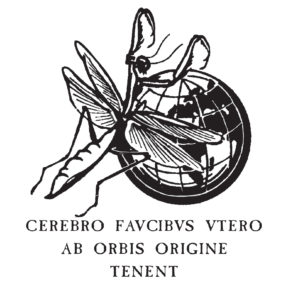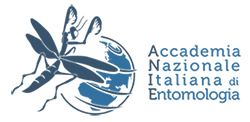Presentation
The Italian National Academy of Entomology, founded in Florence on 16 April 1950, is a consolidated association representing the entire National Entomological Community, erected since 1954 to a Moral Body, by decree of the President of the Republic (Presidential Decree 19/5/1954, no.691) and has legal personality, with registration no. 454 (8/4/2010) of the Legal Persons Register of the Prefecture of Florence.
The Italian National Academy of Entomology is a national point of reference for research and dissemination in the field of entomology.
It promotes the dissemination of insect-related scientific culture at all levels through regular Public Meetings, Publications, National and International Congresses.

Cunning, voracious and fecund, raging since the origin of the world
The four founding members were Professors Athos Goidanich (1905-1987), Professor of Agricultural Entomology at the University of Turin, Guido Grandi (1886-1970), Professor of Agricultural Entomology at the University of Bologna, Remo Grandori (1885-1955), Professor of Agricultural Entomology at the University of Milan and Antonio Melis (1891-1963), Director of the Agricultural Entomology Station of the Ministry of Agriculture, in Florence. The reasons that led these four entomologists to take the initiative were above all the biological complexity of Insects (understood as a zoological class), their importance to mankind and, consequently, the need to increase their study by fostering and collegially coordinating the efforts of the best scholars of Entomology in all its branches, regardless of their professional position.
The first Ordinary Academicians appointed by the founders at the first assembly in November 1950 were in fact a Museum Director (Edoardo Gridelli, 1895-1958, Trieste), three Ordinary Professors of Zoology (Carlo Jucci, 1897-1962, Pavia, particularly known for his studies on Insect Genetics, Mario Salfi, 1900-1970, Naples and Edoardo Zavattari, 1883-1972, Rome), one Full Professor of Zooculture (Anita Vecchi, 1893-1953, Bologna), one Extraordinary Professor of Agricultural Entomology (Filippo Venturi, 1910-1975, Pisa) and one amateur, Ferdinando Solari, President of the Italian Entomological Society, Genoa. At the subsequent meeting in January 1951, another Professor of Zoology (Ludovico Di Caporiacco, 1900-1951, Parma), and a former Museum Director (Giuseppe Muller, 1880-1964, Trieste) were added as Academicians Emeriti. At the same time, three amateurs (Fabio Invrea, 1884-1968, Genoa, Antonio Porta, 1874-1971, Parma and Ruggero Verity, 1883-1959, Florence), a Museum Conservator (Luigi Masi, 1879-1961, Genoa), and a Director of the Ministry of Agriculture’s Experimental Observatory (Giovanni Martelli, 1977-1954, Bari) were appointed as Extraordinary Academicians.
From this first list, it emerges that the National Academy of Entomology had clear ideas right from the start. He sought out the best, not only among Agrarians, but also among Physiologists, Geneticists, Museologists, Ethologists, always regardless of their professional position. In the first period, in fact, a large number of amateur but highly reputable entomologists were brought in. In other words, the Academy looked around carefully, and selected its members where it found them: entomology in those days was in fact mainly practised by the Zoologists of the Faculty of Science, Museologists and Amateurs (favoured by the fact that study techniques were then still very simple), while university agricultural entomology was in its infancy.
The Academy immediately moved with confidence, and was established as a Moral Entity by Decree of the President of the Republic on 19 May 1954. The Statute in force at that time was then amended in 1984 and again on 30 June 1998 (date of publication in the Official Journal). All these changes have led to an increase in the number of Academicians in the various grades, offering the opportunity to include established specialists in the latest and most innovative branches of the great discipline of entomology. The first president, Guido Grandi, ruled the association for about twenty years, until 1969, after him was president Athos Goidanich, from 1969 to 1978, followed by Antonio Servadei, from 1978 to 1979, then Minos Martelli from 1980 to 1986, Rodolfo Zocchi from 1986 to 1994 and Baccio Baccetti in office since 1994. The location followed the relocation of the Stazione di Entomologia Agraria under the name Istituto Sperimentale di Zoologia Agraria, also in Florence, to the Cascine del Riccio, in 1976.
Significant recognition of the Academy’s activities came in 1997, when the Ministry of Cultural and Environmental Heritage included the institution in the Table of Cultural Institutions eligible for ordinary State contributions under Law No. 2 April 1980. 123 Article 1, for the first time in its history, guaranteeing concrete annual funding.
In this half-century of life, the Italian National Academy of Entomology has coordinated the research and results of the work of Italy’s major Entomology Schools, seriously directed the sector’s youthful energies and collegially offered directives to the men, organisations and institutions called upon to do so, placing at the disposal of the country’s government those scientific findings that alone can ensure the fruitfulness of general deliberations and laws to be enacted on the subject.
In its 50 years of scientific and cultural activity, the Academy has also shown itself to be a courageous voice of the highest competence in the field, supporting and validating from the very beginning the concerns of nature associations around the world that are worried about environmental degradation and pollution.
The Academy has made essential contributions both to knowledge in Biology and Ecology, and to the application of research results to areas fundamental to human life such as agriculture and sanitation, thus offering the country and the civilised world free advice – at the highest level of expertise – to protect the environment and human health.
The activity of significant cultural and scientific value also emerges from the following data:
Since its foundation and with the constant commitment of its members, the Academy has promoted scientific research through regular meetings attended by the heads of the most important entomological and biological research institutions.
Scientific research, both pure and applied, in the field of Entomology s.l. is regularly carried out through the Academicians, each of whom is included in or more often directs more or less numerous groups of researchers who carry out laboratory and field research according to views matured or verified in the Academy.
The regular meetings (at least three a year) of the Academy, the conferences with specific themes, the 18 National Congresses held so far in various Italian cities since 1957, are the venues where research is coordinated and discussed and new knowledge and application findings are presented.
The Academy’s commitment to promoting and coordinating the various fields of entomological research in Italy and worldwide culminated in 1996 in Florence with the 20th International Congress of Entomology (never previously held in Italy), which already represents a high recognition of merit by the international scientific community. This event saw the participation of some 3,000 researchers from all over the world and the publication of a massive volume of proceedings.
The National Congresses of Entomology, conceived and organised by the Academy, have always been particularly popular with scholars in the field and have printed the relevant Proceedings, as documentation of the research presented and to support future investigations.
Specialised conferences, also documented by the publication of their Proceedings, dealt with Urban Entomology (1984) and Forest Entomology (1987).
The Round Tables that the Academy has recently initiated at public meetings with contributions from general Entomology, basic and applied research offer further opportunities for open discussion on topical research, also with specialists from outside the Academy.
